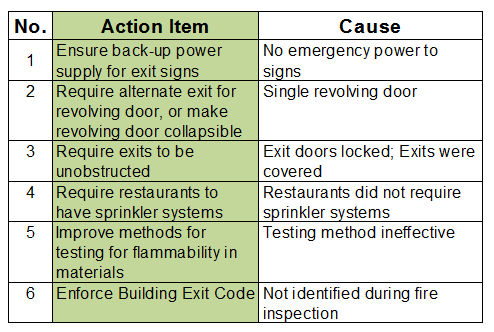Join us for the next Cause Mapping Root Cause Analysis Public Workshop in HOUSTON on April 30 – May 2.
This is an example of how the Cause Mapping process can be applied to a specific incident. In this case the 1942 fire at the Cocoanut Grove Nightclub is captured as an example of the Cause Mapping method. The three steps are 1) Define the problem, 2) Conduct the analysis and 3) Identify the best solutions. Each step will be discussed below.
The first step of the Cause Mapping approach is to define the problem. First we ask four basic questions: What is the problem? When did it happen? Where did it happen? And how did it impact the goals?
In this case, the safety goal was impacted due to the 492 fatalities and 166 injuries. Additionally, the complete destruction of the club can be considered an impact to the property goal, and there was a significant impact to the customer service and production goals. Fire response, medical treatment, cleanup and investigation efforts are an impact to the labor goal.

The analysis step is where the incident is broken down into causes which are captured on the Cause Map. The Cause Map starts by writing down the goals that were affected as defined in problem outline. For the fire at the Cocoanut Grove, the safety goal was impacted because of the 492 fatalities and 166 injuries. This is the first cause-and-effect relationship in the analysis.

The analysis can continue by asking Why questions and moving to the right of either of the cause-and-effect relationships above. In this example we’ll start with the 492 injuries and 166 injuries which resulted from a large fire.

We continue to ask “Why” questions to develop the Cause Map. The large fire started as a small fire, which was due to an ignition source. For this incident, the ignition source was never determined. One popluar theory is that the bus boy, who had dropped a light bulb, lit a match so that he could find it in the darkened corner of the Melody Lounge.

Any fire requires heat, fuel and oxygen.

The heat is the ignition source, which in this case may have been the match. The oxygen was present due to ambient conditions. The fuel was believed to be the flammable, Tropical themed decorations in the club. In addition to fake palm trees, cloth covered the walls and ceilings in the club.

The decorations were flammable because of their material of construction and ineffective fireproofing treatment. In addition, the decorations had been inspected and approved by the fire department, however their method for determining flammability was ineffective.

The speed at which the fire spread throughout the club is still a puzzle to fire experts. However, there were several specific causes that allowed the small fire to become a large fire. The large fire was a result of the small fire, the lack of a sprinkler system and the highly combustible decorations throughout the club. Because the Cocoanut Grove was licensed as a restaurant, and therefore not considered a public place of assembly, it was not required to have a sprinkler system.

The 492 fatalities and 166 injuries resulted from the large fire and the inability of the patrons to exit the club in time.

There were a number of reasons why this happened. Almost as soon as the fire started, the nightclub lost power and the exit signs went dark, lacking an emergency alternate power source. The main front door was a single, revolving door that was not designed to collapse for emergency egress. There were multiple exits that were locked or obstructed with decorations and some of the exits opened in, rather than out, making them useless with panicked patrons rushing forward towards the exit.

Many of these building exit deficiencies could have been addressed had they been identified during the fire inspection. However, Boston had not yet adopted the new Building Exit Code released by the National Fire Protection Association (NFPA) in February of 1942.

Once the Cause Map is built to a sufficient level of detail with supporting evidence, it can be used to develop solutions. The Cause Map is used to identify all the possible solutions for a given issue so that the best solutions can be selected. It is easier to identify many possible solutions from the detailed Cause Map than an oversimplified high level analysis.
Solutions can be documented directly on the Cause Map. Solutions are typically placed in a green box directly above the cause the solution controls. At this stage, all solutions are considered and put on the Cause Map.

After the analysis is complete, the best solutions are selected based on the impacts to the organization’s goals. Shown below are some of the action items that could have prevented the catastrophic loss of life in the Cocoanut Grove nightclub fire.

The Cause Mapping method focuses on the basics of the cause-and-effect principle so that it can be applied consistently to day-to-day issues as well as catastrophic, high risk issues. The steps of Cause Mapping are the same, but the level of detail is different. Focusing on the basics of the cause-and-effect principle make the Cause Mapping approach to root cause analysis a simple and effective method for investigating safety, environmental, compliance, customer, production, equipment or service issues.”
Click on “Download” above to download a PDF showing the Root Cause Analysis Investigation.
Schedule a workshop at your location to train your team on how to lead, facilitate, and participate in a root cause analysis investigation.